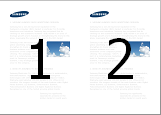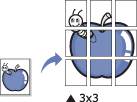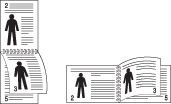|
|
|
|
|
|
|
|
Most Windows applications will override settings you specify in the printer driver. Change all print settings available in the software application first, and change any remaining settings using the printer driver. |
-
For Windows XP Service Pack 3/Server 2003, from the menu, select .
-
For Windows Server 2008/Vista, from the menu, select Control Panel > > .
-
For Windows 7, from the menu, select Control Panel > .
For Windows 8, from the , select > > > .
-
For Windows Server 2008 R2, select > > .
-
For Windows 10 / Windows Server 2016
From task bar, type in in input area. Press the Enter key.
OR
From the (
 ) icon, select > > >.
) icon, select > > >.![[Note]](../../common/icon_note.png)
Right-click the (
 ) icon, you
can select > .
) icon, you
can select > .
-
-
Right-click on your machine.
-
For Windows XP Service Pack 3/Server 2003/Server 2008/Vista, select .
For Windows 7/Windows 8/Windows Server 2008 R2/Windows 10/ Windows Server 2016, from context menus, select .
![[Note]](../../common/icon_note.png)
If has a ►, you can select other printer drivers connected to the selected printer.
-
Change the settings on each tab.
-
Click .
|
|
|
|
If you want to change the settings for each print job, change it in . |
-
For Windows XP Service Pack 3/Server 2003, from the menu, select .
-
For Windows Server 2008/Vista, from the menu, select Control Panel > > .
-
For Windows 7, from the menu, select Control Panel > .
For Windows 8, from the , select > > > .
-
For Windows Server 2008 R2, select > > .
-
For Windows 10 / Windows Server 2016
From task bar, type in in input area. Press the Enter key.
OR
From the (
 ) icon, select > > >.
) icon, select > > >.![[Note]](../../common/icon_note.png)
Right-click the (
 ) icon, you
can select > .
) icon, you
can select > .
-
-
Select your machine.
-
Right-click your machine and select .
![[Note]](../../common/icon_note.png)
For Windows 7 or Windows Server 2008 R2, if has a ►, you can select other printer drivers connected to the selected printer.
Using advanced print features
|
|
|
|
XPS printer driver: used to print XPS file format.
|
You can use advanced printing features when using your machine.
To take advantage of the printer features provided by your printer driver, click or in the application’s window to change the print settings. The machine name that appears in the printer properties window may differ depending on the machine in use.
|
|
|
|
|
Item |
Description |
|||
|---|---|---|---|---|
|

|
Selects the number of pages to print on a single sheet of paper. To print more than one page per sheet, the pages will be reduced in size and arranged in the order you specify. You can print up to 16 pages on one sheet. |
|||
|

|
Prints a single-page document onto 4 (Poster 2x2), 9 (Poster 3x3), or 16 (Poster 4x4) sheets of paper, for the purpose of pasting the sheets together to form one poster-size document. Select the value. Specify in millimeters or inches by selecting the radio button on the upper right of tab to make it easier to paste the sheets together. 
|
|||

|
Prints your document on both sides of a sheet of paper and arranges the pages so that the paper can be folded in half after printing to produce a booklet.
|
|||
|
|
Print on both sides of a sheet of paper (duplex). Before printing, decide how you want your document oriented.
|
|||
|
|
|
|||
|

|
Changes the size of a document to appear larger or smaller on the printed page by entering in a percentage by which to enlarge or decrease the document. |
|||
|

|
The watermark option allows you to print text over an existing document. For example, you use it when you want to have large gray letters reading “” or “” printed diagonally across the first page or all pages of a document. |
|||
|
|
|
|||
|
|
|
|||
|
|
|
|||

|
This option is available only when you use the PCL/SPL printer driver. An overlay is text and/or images stored in the computer hard disk drive as a special file format that can be printed on any document. Overlays are often used to take the place of letterhead paper. Rather than using preprinted letterhead, you can create an overlay containing exactly the same information that is currently on your letterhead. To print a letter with your company’s letterhead, you do not need to load preprinted letterhead paper in the machine: just print the letterhead overlay on your document. To use a page overlay, you must create a new page overlay containing your logo or image.
|
|||
|
To use a page overlay, you must create a new page overlay containing your logo or image.
|
||||
|
After an overlay has been created, it is ready to be printed with your document. To print an overlay with a document:
|
||||
|
You can delete page overlays that you no longer use.
|
||||
|
|
This option allows you to print with the given permission.
|
|||
|
[a] This option is not available when you use XPS driver. |
||||
|
|
|
|
What is Direct Printing Utility?
Direct Printing Utility is a program that sends the PDF files directly to your machine to print without having to open the file.
To install this program:
Download the software from the Samsung website then unpack and install it: (http://www.samsung.com > find your product > Support or Downloads).
|
|
|
|
Printing
There are several ways you can print using the Direct Printing Utility.
-
From the menu select or > .
-
For Windows 8, from , select > .
-
For Windows 10 / Windows Server 2016
From task bar, type in in input area. Press the Enter key.
OR
From the (
 ) icon, select > .
) icon, select > .
-
-
Press Direct Printing Utility.
-
Select your machine from the drop-down list and click .
-
Select the file you wish to print and click .
The file is added in the section.
-
Customize the machine settings for your needs.
-
Click . The selected PDF file is sent to the machine.
Using the right-click menu
-
Right-click on the PDF file to print and select .
The Direct Printing Utility window appears with the PDF file is added.
-
Select the machine to use.
-
Customize the machine settings.
-
Click . The selected PDF file is sent to the machine.

